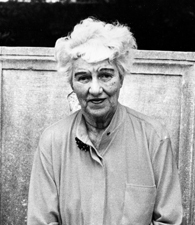American heiress Peggy Guggenheim was considered to be as intriguing as the art she collected. One of the pioneering collectors of Abstract Expressionism, she had a particular fondness for surrealism, cubism and sculpture. At the height of her career, she amassed a piece of art per day.
Peggy Guggenheim’s Early Days
Marguerite “Peggy” Guggenheim was born August 26, 1898, to wealthy industrialist Benjamin Guggenheim and his wife, Florette Seligman. Growing up in one of the most well-connected Jewish families in New York. Peggy was mostly home-schooled, and had a rather isolated childhood.
In 1912, Benjamin Guggenheim went down with the Titanic. Though it was one of the biggest tragedies of her life, it allowed Peggy access to her inheritance. At 21, she began receiving $22,500 a year, enough to travel and begin collecting art.
When she was 22, Peggy volunteered at the avant-garde bookshop Sunwise Turn. The experience inspired her love of art and bohemian society, and it was there that she met her first husband, writer Laurence Vail. She encountered him again in Paris; they married and had two children, but the union was an unhappy one. When Peggy and Laurence divorced in 1930, she moved to London.
Sources in this Story
- Peggy Guggenheim Collection: Peggy Guggenheim
- The New York Observer: Acquiring Art, Acquiring Men: The Busy Life of an Heiress
- The New York Times: Paying Tribute to the Daring of Peggy Guggenheim
- The Guardian: Never mind the Pollocks
- Vanity Fair: The Bitter Legal Battle over Peggy Guggenheim’s Blockbuster Art Collection
- The New York Times: A Collector of Art and Artists Tells All and Then Some
Guggenheim’s Art Collecting
In London, Guggenheim opened her first modern art gallery, Guggenheim Jeune, featuring artists like Wassily Kandinsky, Yves Tanguy and Pablo Picasso. Although she didn’t actually know very much about art when she started, she fortunately had Marcel Duchamp as her mentor.
It was the gallery that ultimately prompted her to start collecting: “Gradually I bought one work of art from every show I gave, so as not to disappoint the artists if I were unsuccessful in selling anything,” she wrote.
In 1939, Guggenheim’s ambition increased, and she decided to open a modern art museum in London. Working with Duchamp and art advisor Harold Reed, she vowed to buy “a piece a day.”
In 1941, the approach of the German army drove Guggenheim to flee Europe with her fiancé, artist Max Ernst. She quickly established an art museum in New York called “Art of this Century.” Guggenheim continued to support abstract and surrealist painters, and was an especially enthusiastic admirer of the American movement of Abstract Expressionism.
In 1947, she moved to Italy and exhibited her collection at the 1948 Venice Biennale. Twenty-two years later, Peggy donated her collection to the Solomon F. Guggenheim Foundation, which had been established by her uncle.
The Woman and Her Work
- “Confessions of an Art Addict”
- “Mistress of Modernism: The Life of Peggy Guggenheim,” by Mary V. Dearborn
- “Art Lover,” by Anton Gill
The Rest of the Story
Peggy Guggenheim was as fond of men as she was of art, and her busy love life was part of her allure. According to Stuart Jeffries of The Guardian, “She was a woman whose commission…could transform the reputation of an artist. Indeed, the promise of that prestige may have been an aphrodisiac for some of her artist lovers.”
Peggy Guggenheim died on December 23, 1979, at her home at Palazzo Venier dei Leoni in Italy, and is buried there. Since her death, the Guggenheim Foundation has turned her home into a museum and has continued to expand upon her collection. That collection, and how it has been managed, has been the focus of a longstanding legal battle among Guggenheim’s heirs and the foundation.
Amy Madigan portrayed her colorful personality in the film “Pollock,” and actress Mercedes Ruehl won an Obie Award playing Peggy Guggenheim in a one-woman show about her life, “Woman Before A Glass.”
This article was originally written by Isabel Cowles; it was updated August 21, 2017.











